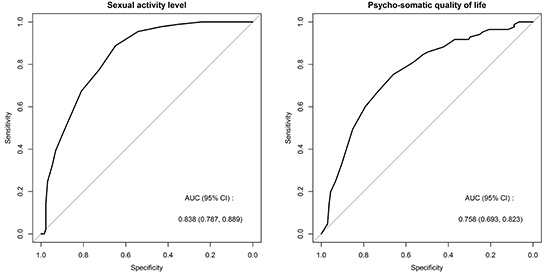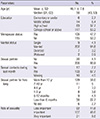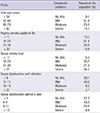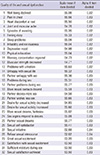1. Ligibel JA, Denlinger CS. New NCCN guidelines for survivorship care. J Natl Compr Canc Netw. 2013; 11:640–644.
2. Yoo SH, Yun YH, Park S, Kim YA, Park SY, Bae DS, Nam JH, Park CT, Cho CH, Lee JM. The correlates of unemployment and its association with quality of life in cervical cancer survivors. J Gynecol Oncol. 2013; 24:367–375.
3. Lee SS, Chung HY, Yu W. Quality of life of long-term survivors after a distal subtotal gastrectomy. Cancer Res Treat. 2010; 42:130–134.
4. Robinson JG, Molzahn AE. Sexuality and quality of life. J Gerontol Nurs. 2007; 33:19–27.
5. Rosen RC, Riley A, Wagner G, Osterloh IH, Kirkpatrick J, Mishra A. The international index of erectile function (IIEF): a multidimensional scale for assessment of erectile dysfunction. Urology. 1997; 49:822–830.
6. Rosen R, Brown C, Heiman J, Leiblum S, Meston C, Shabsigh R, Ferguson D, D'Agostino R Jr. The Female Sexual Function Index (FSFI): a multidimensional self-report instrument for the assessment of female sexual function. J Sex Marital Ther. 2000; 26:191–208.
7. King MT. The interpretation of scores from the EORTC quality of life questionnaire QLQ-C30. Qual Life Res. 1996; 5:555–567.
8. Sprangers MA, Groenvold M, Arraras JI, Franklin J, te Velde A, Muller M, Franzini L, Williams A, de Haes HC, Hopwood P, et al. The European Organization for Research and Treatment of Cancer breast cancer-specific quality-of-life questionnaire module: first results from a three-country field study. J Clin Oncol. 1996; 14:2756–2768.
9. Greimel E, Bottomley A, Cull A, Waldenstrom AC, Arraras J, Chauvenet L, Holzner B, Kuljanic K, Lebrec J, D'haese S. An international field study of the reliability and validity of a disease-specific questionnaire module (the QLQ-OV28) in assessing the quality of life of patients with ovarian cancer. Eur J Cancer. 2003; 39:1402–1408.
10. Van Andel G, Bottomley A, Fosså SD, Efficace F, Coens C, Guerif S, Kynaston H, Gontero P, Thalmann G, Akdas A, et al. An international field study of the EORTC QLQ-PR25: a questionnaire for assessing the health-related quality of life of patients with prostate cancer. Eur J Cancer. 2008; 44:2418–2424.
11. Heinemann LA, Potthoff P, Heinemann K, Pauls A, Ahlers CJ, Saad F. Scale for Quality of Sexual Function (QSF) as an outcome measure for both genders? J Sex Med. 2005; 2:82–95.
12. Song SH, Jeon H, Kim SW, Paick JS, Son H. The prevalence and risk factors of female sexual dysfunction in young Korean women: an internet-based survey. J Sex Med. 2008; 5:1694–1701.
13. Lee ZN. Korean culture and sense of shame. Transcult Psychiatry. 1999; 36:181–194.
14. Moreira ED Jr, Kim SC, Glasser D, Gingell C. Sexual activity, prevalence of sexual problems, and associated help-seeking patterns in men and women aged 40-80 years in Korea: data from the Global Study of Sexual Attitudes and Behaviors (GSSAB). J Sex Med. 2006; 3:201–211.
15. Ahn TY, Lee DS, Kang WC, Hong JH, Kim YS. Validation of an abridged Korean version of the International Index of Erectile Function (IIEF-5) as a diagnostic tool for erectile dysfunction. Korean J Urol. 2001; 42:535–540.
16. Choi JH, Kim TJ, Shin K, Choi CB, Kim JH, Kim SH, Kim NI, Ahn MJ, Jung HJ, Lee KE, et al. The reliability and validity of a Korean translation of the ASAS health index and environmental factors in Korean patients with axial spondyloarthritis. J Korean Med Sci. 2014; 29:334–337.
17. Park HJ, Yang HK, Shin DW, Kim YY, Kim YA, Yun YH, Nam BH, Bhatia S, Park BK, Ghim TT, et al. Cross-cultural adaptation of the Korean version of the minneapolis-manchester quality of life instrument-adolescent form. J Korean Med Sci. 2013; 28:1788–1795.
18. Kim HY, So HS, Park KS, Jeong SJ, Lee JY, Ryu SB. Development of the Korean-version of female sexual function index (FSFI). Korean J Androl. 2002; 20:50–56.
19. Yun YH, Park YS, Lee ES, Bang SM, Heo DS, Park SY, You CH, West K. Validation of the Korean version of the EORTC QLQ-C30. Qual Life Res. 2004; 13:863–868.
20. Fayers PM, Aaronson NK, Bjordal K, Groenvold M, Curran D, Bottomley A. EORTC QLQ-C30 scoring manual. Brussels: European Organisation for Research and Treatment of Cancer;2001.
21. Snyder CF, Blackford AL, Okuyama T, Akechi T, Yamashita H, Toyama T, Carducci MA, Wu AW. Using the EORTC-QLQ-C30 in clinical practice for patient management: identifying scores requiring a clinician's attention. Qual Life Res. 2013; 22:2685–2691.
22. Nicolosi A, Glasser DB, Kim SC, Marumo K, Laumann EO. GSSAB Investigators' Group. Sexual behaviour and dysfunction and help-seeking patterns in adults aged 40-80 years in the urban population of Asian countries. BJU Int. 2005; 95:609–614.
23. Moreira ED Jr, Brock G, Glasser DB, Nicolosi A, Laumann EO, Paik A, Wang T, Gingell C. GSSAB Investigators' Group. Help-seeking behaviour for sexual problems: the global study of sexual attitudes and behaviors. Int J Clin Pract. 2005; 59:6–16.
24. Nappi RE, Lachowsky M. Menopause and sexuality: prevalence of symptoms and impact on quality of life. Maturitas. 2009; 63:138–141.
25. Parker R. Sexuality, culture and society: shifting paradigms in sexuality research. Cult Health Sex. 2009; 11:251–266.
26. Pereira VM, Silva ACdO, Nardi AE, Heinemann LA. Translation and cross-cultural adaptation into Brazilian Portuguese of the Scale for Quality of Sexual Function (QSF). Rev psiquiatr Rio Gd Sul. 2011; 33:87–97.





 PDF
PDF ePub
ePub Citation
Citation Print
Print









 XML Download
XML Download